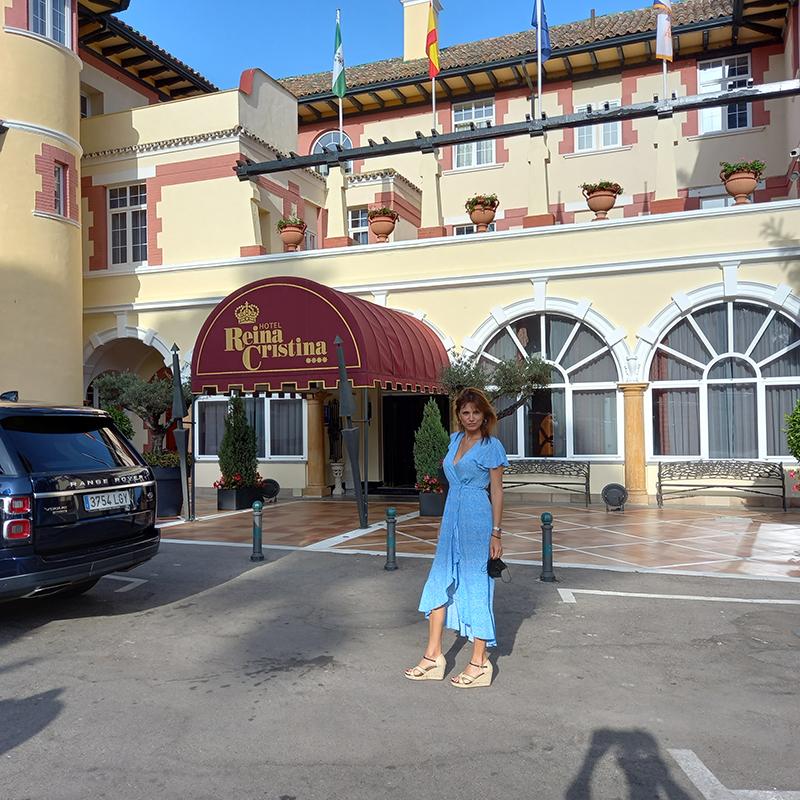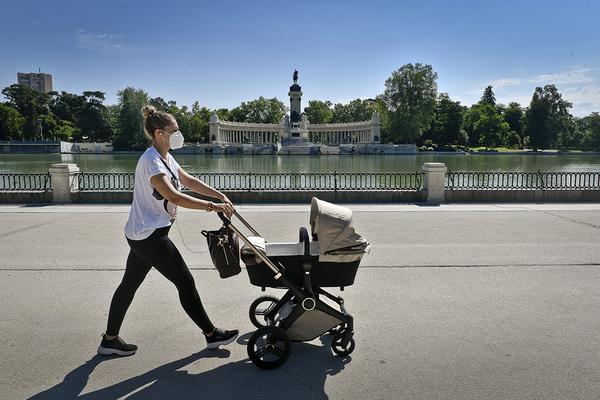Italian, a literary journey (II)
The house of Puente Mayorga
“The beach was deserted. On one side, the curve of sand that led to the town of La Línea and the border, and on the other, the distant and loose houses of the fishermen from Puente Mayorga, who fished in the bay at that time”.
The reader begins this novel at dawn in Algeciras with the woman who has to decide on the life of a man who has vanished on the cold sand. On the other side of the sea, the Second War loads with atrocities the memory of a world that collapses while they fall in love.
The house of this woman of Aragonese descent (Arbués) where she lives alone with her dog of Homeric reminiscences (Argos) is “a hundred steps from the shore”. A “small one-story house surrounded by palm trees and bougainvillea” where Theseus saves himself from her thanks to rubbing alcohol on her chest and arms, but above all thanks to her complicit silence.
"That house is located in Puente Mayorga, district of San Roque, on a small private beach that today is barely visible from the road"
This house is located in Puente Mayorga, in the district of San Roque, on a small private beach that today is barely visible from the road. Near that place lived two historical figures who actually acted as Italian spies at that time, and to whom Pérez-Reverte winks in the novel when the elderly Elena Arbués corrects a fact from the journalist's chronicle:
“You have confused me with Conchita Peris del Corral, a Spanish woman married to the Italian agent Antonio Ramognino… The couple lived, like me, near the beach; although they were a little further away, in a house called Villa Carmela”.
The author Alfonso Escuadra Sánchez, in number 41 of the Almoraima magazine (2014), dedicated to the dissemination of the history and heritage of the Gibraltarian region, tells an exciting spy story starring the Italian couple Antonio and Conchita Ramognino, who are entrusted with a very special mission: to secretly travel to Spanish territory and locate the ideal place on the coast of the Bay of Algeciras to set up the future base of operations for the Tenth. Finally, Antonio decides what the place will be:
“I have seen a country house for rent that is ideal… It is located on a small elevation that leads to a private beach in Puente Mayorga, near La Línea. A large number of merchantmen from the convoys drop anchor there after crossing the Straits, some of them barely two thousand meters from the coast, others barely six hundred. Every movement they make is perfectly visible from the house.
Antonio and Conchita
Villa Carmela
Taking a leap from reality to literature, Elena Arbués will precisely dial the Villa Carmela telephone number (although at first she does not know where she is calling) and Lieutenant Mazzantini will come to pick up Teseo that first night.
"We had already traveled this revertian landscape, in some way, in La Reina del Sur, where a piece of Teresa Mendoza's life takes place precisely here"
The geography of El Italiano is today a quilt of three towns connected by the Gibraltar Highway (CA-34), the main access road to Algeciras, Puente Mayorga and La Línea de la Concepción, starting at the Mediterranean Highway and ending at the Spanish police checkpoint located next to the British Overseas Territory of Gibraltar.
By the way, this landscape so revertian made up of a piece of Algeciras, a single woman and a little house on the beach, also told by the narrative voice of a fictional journalist, we had already covered it, in some way, in La Reina del Sur, where a piece of Teresa Mendoza's life takes place precisely here. The house of the unforgettable Mexican was “a little chalet located ten meters from the water, at the mouth of the Palmones River, where some fishermen's houses stood right in the middle of the bay between Algeciras and Gibraltar. He liked that area that reminded him a bit of Altata, in Sinaloa, with sandy beaches, and blue and red boats stranded next to the calm water of the river.”
Teresa Mendoza, like Elena Arbués, also had her reference bars in the area: she used to have breakfast of coffee with toasted oil in El Espigón or Estrella de Mar, and eat shrimp omelettes on Sundays at Casa Willy, in Palmones , a town close to Puente Mayorga and which fortunately still exists.
Gathering and books
The life of the young widow takes place between her house on the beach and La Línea de la Concepción, where she has her book store and her social gathering friends, so after stopping the car for a moment on the shoulder and walking for a while between eucalyptus trees to the Puente Mayorga beach, I continue in the direction of La Línea.
La Linea Bar
La Modelo waiters
It's early, but the town is bustling with life. I look for the Café Anglo-Hispano, where once a week Elena would meet with her friends, Dr. Zocas, an expert in trains, the blond Pepe Aljaraque, the town hall archivist, and Nazaret Castejón, the municipal librarian.
"It fits perfectly with the fictional description of the Anglo-Hispanic, although its real name is Cafeteria Modelo"

The place is not to be missed. Located in the central Calle Real, today a pedestrian street, I find a place that still preserves the flavor of the forties and that, moreover, fits perfectly with the fictional description of the Anglo-Hispanic, although its real name is Cafeteria Modelo. I sit on the terrace to have a delicious, very dark coffee and some churros, and I ask the kind waiter, who tells me, with pride from Línea, the history of this mythical place:
“Among the most important establishments that our city has had was without a doubt, this one: the Confectionery, Cafeteria and Restaurant Modelo, which was inaugurated in 1902, being its first owner Doña Ana Ríos. Later, Don José Calvente Cabello, an employee of the La Chiquita confectionery, which still exists and is next door, will buy it for 12,000 reais. My grandparents told me about the fame of their meringues, the cream cubes, the exotic "Japanese", the bacon from heaven and some famous rosaries of pieces of fruit, typical of Easter, which were of Italian origin".
The waiter stops and winks at me, pointing to the title of the book on my knee. I nod and smile, and he continues, enthused by this customer who pays him all the attention in the world and even writes down everything she says in her pad.
“You can imagine that this place was made up of a very select clientele, with political and artistic gatherings and the best of the area; intellectuals, wealthy couples, businessmen and foreign politicians who used to stay at the Príncipe Alfonso Hotel, in the nearby town of Campamento”.
Calle Real, La Linea
Calle Real The line, today
He stops again and looks at me, analytical. “You are from Seville, right? He has a slight accent from there." Without waiting for an answer, with that veteran wisdom that comes from professional dealings with the public, he continues his story.
“Well then. Know that this café tried to emulate, in terms of decoration and elegance, the Great Britz of Seville, which no longer exists, although the building is still there, it seems to me”.
“Yeah,” I say. It is a beautiful construction by Aníbal González. Today I think it houses a huge clothing store.
The waiter nods, resigned. "Clear. Clothing stores everywhere. Thoughtful, he resumes the speech.
“This café was said to be one of the best establishments in Spain. Undoubtedly, it deserved the description of "model", as it was modern and luxurious, with spacious rooms and an extensive and well-stocked bar, behind which was the kitchen, in charge of the chef Sarria, who served excellent meals in the annexed Restaurant Lounge. For a time there were even dances held every Saturday with an orchestra upstairs, and I assure you, miss, those lucky enough to experience it were fondly remembered.
I thankfully say goodbye to the waiter at La Modelo, leaving a generous tip, and walk down the busy Calle Real looking for the Circe bookstore, run by Elena Arbués.
"I have reserved a table at the restaurant La Flute Mágica, where they serve the best Moroccan harira that one can taste on this side of the Mediterranean"
On Calle Real in the novel, the bookstore is located “next to the La Escocesa fabric store”. On today's Calle Real, that store miraculously still stands, as well as pharmacies, bars and the delicious Círculo Mercantil building, painted white and sky blue, but not a trace of bookstores. It doesn't matter, because thanks to the magic of literature and this novel, I can look out with Elena at the window "illuminated by twenty-watt bulbs" and enjoy the editorial novelties of that time: "Don Juan de Marañón, César's Commentaries, Carlos de Europa by Wyndham Lewis, El paraíso y la Serpiente de Pemán… although my eyes wander behind the detective works posted below: Salgari, Zane Grey, Oppenheim, Edgar Wallace or the wonderful Mystery of the Blue Train by Agatha Christie in a brand new second edition.
There is another bookstore that will play a fundamental role in the espionage plot of this story and that is located on the other side of the border, in Gibraltar. That's where I'm going now, although first I'll deviate a few kilometers to take a walk through Algeciras, to see if I run into Teseo and his companions from the Tenth. Also, I have reserved a table at the restaurant La Flute Mágica, where they serve the best Moroccan harira that one can taste on this side of the Mediterranean.
The man of the last quarter moon
Theseus is a singular protagonist. Everything we know about him is thanks to the other characters; to the woman's gaze, to what her colleagues tell us, to the chronicle of the fictional journalist who tells the story of El Italiano.
Glances, gestures, physical appearance, attitudes and silences build an indisputably revertian character very much in the vein of the reporter and painter of battles Faulques, of Max Costa, "mundane dancer", of the Cadiz-born Captain Lobo, or of the drug-trafficking pilot in Gibraltar Santiago Fisterra. His best friend, Genaro, says of him that he is "one of many who were born heroes and don't know it."
Britz, Seville
La Linea Casino
Elena's first encounter with the hero of this story takes place in the busy streets of downtown Algeciras. Theseus walks with his companions, and it is one of them, the Neapolitan Squarcialupo, who realizes that the girl is following them. He discovers her watching them sitting in the Miramar bar-restaurant, in front of the port that no longer exists, since this is precisely the area that has suffered the most from urban updates due to the extensions and improvements of the port area, which has been gaining ground from the sea with huge dock infrastructures for the reception of international merchandise, storage and logistics, as well as a network of offices and boarding points for the various shipping companies that make the Algeciras-Tangier route.
"Enter this kind of flying saucer made of concrete so light that it seems to float between the fruit stalls"
However, reading, one can easily imagine the lively and colorful environment of this place near the Galera dock in those years and point the way on the map following the handsome Theseus through the labyrinth of the city, Cánovas street up the Castle, until you reach the Torroja market square. In this place lovers speak for the first time when they are still two strangers:
“With an almost imperceptible movement he touched her elbow […]. She follows him, or rather, she lets herself be carried away on the wet floor that smells of fish and the sea."
Just for that scene, the reader is forced to stop:
“Under the modern circular lighthouse the voices of the vendors resound and it looks more like a Moorish souk than a Spanish market”, the author tells us.
Designed in the rationalist style by the engineer Torroja shortly before the outbreak of the Civil War, this market has always been one of my favorite buildings in Andalusia. Entering this kind of flying saucer made of concrete so light that it seems to float among the fruit stalls and doing it first thing in the morning, when the light fills the geometric holes in the rose window with shadows, is like entering a Gropius plane, a Mies pavilion or attending the inauguration of that mythical exhibition at the MOMA by Russell Hitchcock and Philip Johnson held just two years before this building was erected that strangely reigns in the center of the Algeciras square as in a world that does not belonged to him.
Libería Calle Real, La linea.
Plaza Alta, Algeciras
A world of street stalls, vendors, mixed smells, accentuated by the heat of the relentless Andalusian sun that reminds the sottocapo Squarcialupo so much of his land and the bustling place where he was born, the Neapolitan via Pignaseca, to which Arturo Pérez- Reverte dedicated an article in XL Semanal long ago entitled "The inspector and the fishmonger."
Ascending a distance from the market you will reach the heart of Algeciras: the Plaza Alta, in one of whose corners stands a beautiful church that raises its bell tower over the colorful ceramics of this square where children play and the population strolls idly when the sun goes down
"I want to see a little revenge from Pérez-Reverte against that unjust cinematographic death in the act of bringing back to life this man who has become the lieutenant of the ship Mazzantini"
Next to the ceramic sign indicating the name of the place, a narrow alley meanders flanked by a buttressed building that appears to be under construction. In another time there was the Ritz hotel from which the alley takes its name, and in that precise corner is where Elena observes the men of the last quarter moon for the first time since Theseus disappeared from his home and his life without a trace. .
Barely five minutes of pleasant walk downhill separate the upper area of Algeciras from Virgen del Carmen avenue, where that harira awaits me, almost as good as the Moorish tea and the sweet gazelle horns, which I give up because I don't like them. there's a lot of time left. I have an appointment with the spies at the Reina Cristina hotel and I cannot, under any circumstances, be late.
Room 246
“Pass among the palm trees and bougainvillea that adorn the entrance, agitated by the east, and smile at the uniformed doorman who, in front of the porch columns, touches the visor of his cap”.
Elena Arbués, elegant and discreet, has a vital appointment on the second floor of this hotel, one of the most elegant at the moment. In room 246, Theseus and a blond gentleman who looks like Amedeo Nazzari, the actor who plays the Italian commander Fornari in the magnificent film I due nemici, where he dies under English fire during an attack by British troops in Abyssinia at the beginning of the of the 40s, more or less on the same dates in which this novel takes place. I want to see a little revenge from Pérez-Reverte against that unjust cinematographic death in the act of bringing back to life this man who has become the lieutenant of the ship Mazzantini, responsible for the men of the Orsa Maggiore group, who will make the English enemy sweat with fear during the months that the night raids of the fearsome Maiali will last.
Torroja Market, Algeciras
Gardens of the Reina Cristina hotel
After almost two years of a pandemic with its doors closed, the Reina Cristina hotel reopened last summer. Bordered by gardens and facing the sea, the establishment maintains the deliciously decadent flavor of the architecture with Moorish airs so typical of the area, with its lobed arches in the patio, the ceramic lacework walls and the golden inlaid ceilings, although its enigmatic story transcends this Casablanca atmosphere and would undoubtedly make for a complete novel.
Not in vain is it one of the oldest hotels in Andalusia, and great international political personalities have stayed there: Franklin D. Roosevelt, Winston Churchill, Alfonso XIII, Charles de Gaulle, Mariscal Pétain, the queens from Belgium and Italy... In addition, the Algeciras Conference took place in this same hotel, which would forever change the course of history. On the other hand, the Reina Cristina gardens still keep the vestiges of the main mosque of the old Muslim kingdom, as well as remains of its medieval walls.
"The most succulently romantic episode deals with the activity of the hotel during World War II, when it became a veritable nest of spies"
However, the most succulently fictional episode deals with the activity of the hotel during World War II, when it became a veritable nest for Nazi spies, which would even lead them to use passageways inside the hotel to avoid being discovered:
Through a shaft, which we can still find next to the hotel pool (going unnoticed by anyone who does not know this secret), we access the main tunnel that German and Italian spies used during their stay in Algeciras. The other entrance to the tunnel is located in the current machine room. From it a passageway runs through the basement of the Reina Cristina, reaching a booth on the outskirts of the hotel, today walled up, where there are still two other large wells that the spies used to enter directly from the waters of the bay, avoiding calling the attention.
Anglo Hispano Hotel
German spy
The mouth of one of the Reina Cristina tunnels
It is said that, through this network of tunnels, the divers of the Decima Flotiglia MAS (the real ones) accessed the bay to place the sticky bombs on the English ships and return again, like shadows, and disappear in this underground network.
Linked to that moment and to this hotel is also the character of a mysterious woman, Larissa Swirski, the Mata Hari of the South, a Nazi secret agent whose mission was to spy on naval movements off Gibraltar. She lived coming and going to this same Reina Cristina hotel, attending her mythical parties and her secret meetings.
"I drive slowly, next to the sea, towards the Rock, that English lion's paw in Spanish territory"
But not only German and Italian agents were operating in Algeciras: the English also intensified counter-espionage work in the city, staying in another hotel in the city, the Anglo Hispano, at the foot of the Miel river, whose walls are also They kept unspeakable secrets.
Back to the car located in a public parking lot next to the dry stream of that same river of La Miel, I walk along the narrow sidewalk in front of the monstrous port facilities and I think about how important literature continues to be to preserve memory, being able, thanks to her, to erase page by page the ugly reality and replace it with some beautiful certainties.
I drive slowly, next to the sea, towards the Rock, that English lion's paw in Spanish territory, knowing that the future of the Second World War was played in part here, in Algeciras, where one of the great battles took place, that of espionage. Thanks, among other things, to this novel by Arturo Pérez-Reverte, today I cross the English border of Gibraltar with a new look of balanced pride for the land that I leave on the other side of the fence.
******
Part one: Italian, a literary journey
Part Three: Shadows on the Bay
4.5/5(90 Ratings. Rate this article, please)







